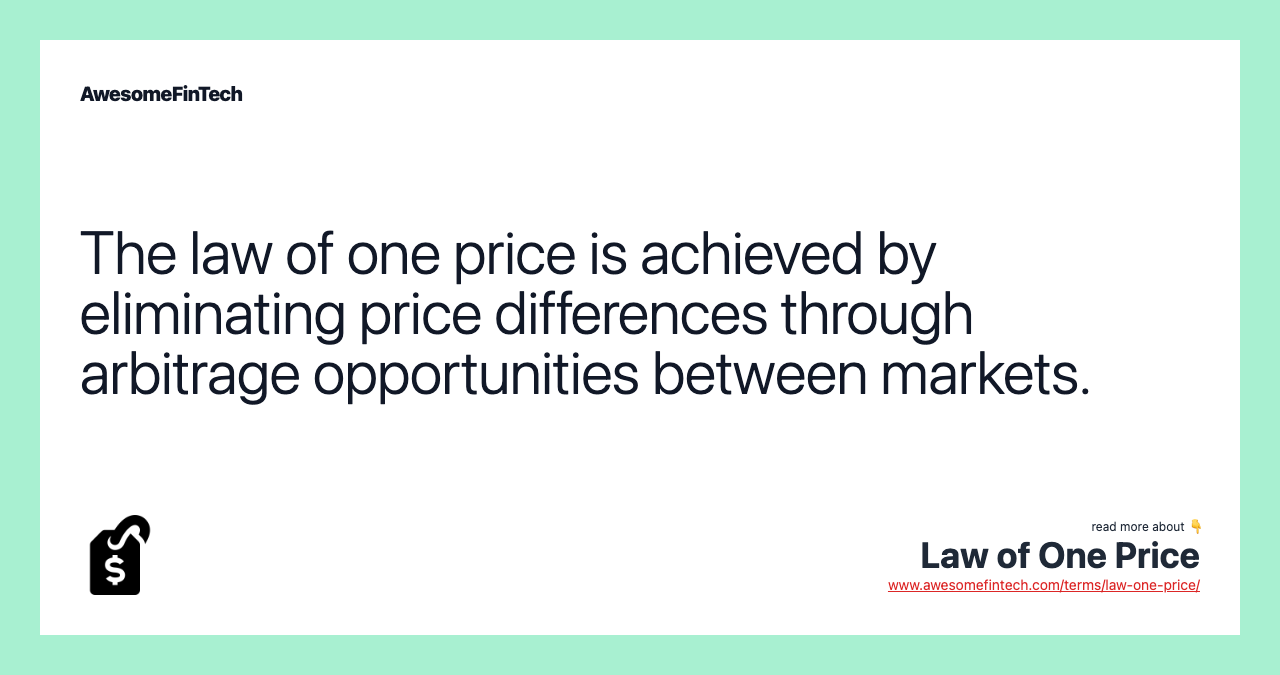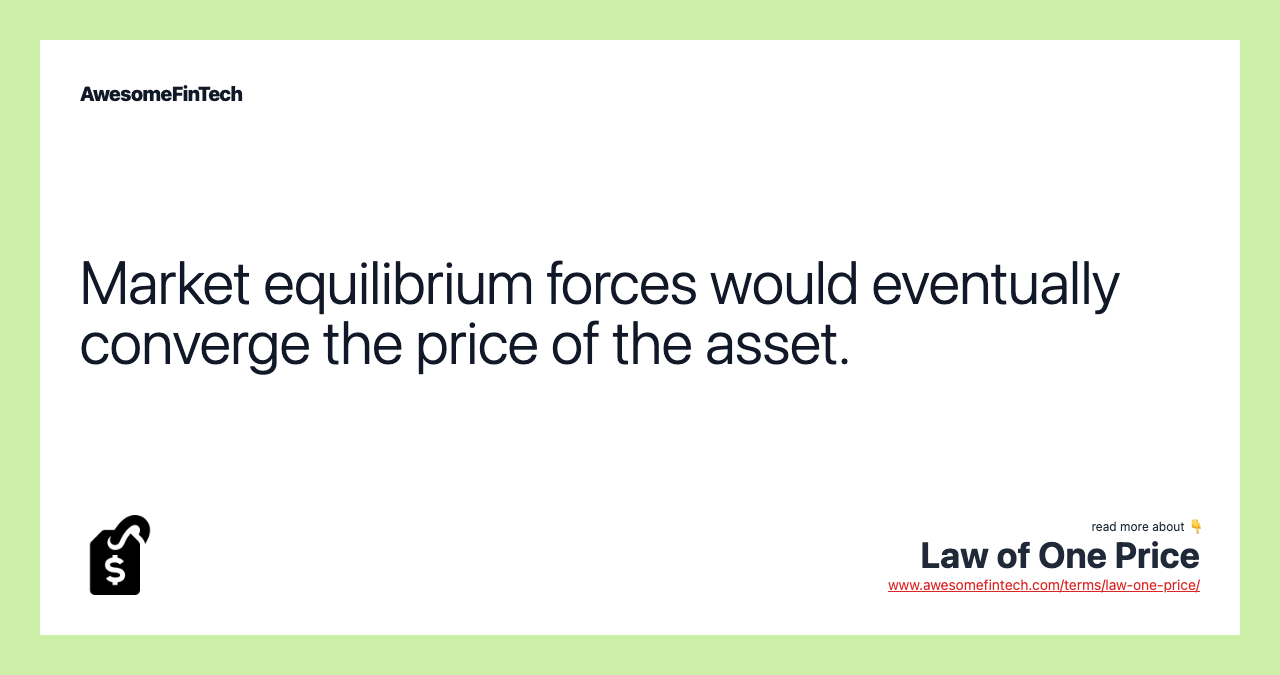Law of One Price
The law of one price is an economic concept that states that the price of an identical asset or commodity will have the same price globally, regardless of location, when certain factors are considered. If the price of any economic good or security is inconsistent in two different free markets after considering the effects of currency exchange rates, then to earn a profit, an arbitrageur will purchase the asset in the cheaper market and sell it in the market where prices are higher. The law of one price takes into account a frictionless market, where there are no transaction costs, transportation costs, or legal restrictions, the currency exchange rates are the same, and that there is no price manipulation by buyers or sellers. Where transaction costs, such as the costs to find an appropriate trading counterparty or costs to negotiate and enforce a contract, are higher, the price for a good will tend to be higher there than in other markets with lower transaction costs. The law of one price is an economic concept that states that the price of an identical asset or commodity will have the same price globally, regardless of location, when certain factors are considered.

More in Economy
What Is the Law of One Price?
The law of one price is an economic concept that states that the price of an identical asset or commodity will have the same price globally, regardless of location, when certain factors are considered.
The law of one price takes into account a frictionless market, where there are no transaction costs, transportation costs, or legal restrictions, the currency exchange rates are the same, and that there is no price manipulation by buyers or sellers. The law of one price exists because differences between asset prices in different locations would eventually be eliminated due to the arbitrage opportunity.
The arbitrage opportunity would be achieved whereby a trader would purchase the asset in the market it is available at a lower price and then sell it in the market where it is available at a higher price. Over time, market equilibrium forces would align the prices of the asset.



Understanding the Law of One Price
The law of one price is the foundation of purchasing power parity. Purchasing power parity states that the value of two currencies is equal when a basket of identical goods is priced the same in both countries. It ensures that buyers have the same purchasing power across global markets.
In reality, purchasing power parity is difficult to achieve, due to various costs in trading and the inability to access markets for some individuals.
The formula for purchasing power parity is useful in that it can be applied to compare prices across markets that trade in different currencies. As exchange rates can shift frequently, the formula can be recalculated on a regular basis to identify mispricings across various international markets.
Example of the Law of One Price
If the price of any economic good or security is inconsistent in two different free markets after considering the effects of currency exchange rates, then to earn a profit, an arbitrageur will purchase the asset in the cheaper market and sell it in the market where prices are higher. When the law of one price holds, arbitrage profits such as these will persist until the price converges across markets.
For example, if a particular security is available for $10 in Market A but is selling for the equivalent of $20 in Market B, investors could purchase the security in Market A and immediately sell it for $20 in Market B, netting a profit of $10 without any true risk or shifting of the markets.
As securities from Market A are sold on Market B, prices on both markets should change in accordance with the changes in supply and demand, all else equal. Increased demand for these securities in Market A, where it is relatively cheaper, should lead to an increase in its price there.
Conversely, increased supply in Market B, where the security is being sold for a profit by the arbitrageur, should lead to a decrease in its price there. Over time, this would lead to a balancing of the price of the security in the two markets, returning it to the state suggested by the law of one price.
Violations of the Law of One Price
In the real world, the assumptions built into the law of one price frequently do not hold, and persistent differentials in prices for many kinds of goods and assets can be readily observed.
Transportation Costs
When dealing in commodities, or any physical good, the cost to transport them must be included, resulting in different prices when commodities from two different locations are examined.
If the difference in transportation costs does not account for the difference in commodity prices between regions, it can be a sign of a shortage or excess within a particular region. This applies to any good that must be physically transported from one geographic location to another rather than just transferred in title from one owner to another. It also applies to wages for any employment where the worker must be physically present at the worksite to perform the job.
Transaction Costs
Because transaction costs exist and can vary across different markets and geographic regions, prices for the same good can also vary between markets. Where transaction costs, such as the costs to find an appropriate trading counterparty or costs to negotiate and enforce a contract, are higher, the price for a good will tend to be higher there than in other markets with lower transaction costs.
Legal Restrictions
Legal barriers to trade, such as tariffs, capital controls, or in the case of wages, immigration restrictions, can lead to persistent price differentials rather than one price. These will have a similar effect to transportation and transaction costs, and might even be thought of as a type of transaction cost. For example, if a country imposes a tariff on the importation of rubber, then domestic rubber prices will tend to be higher than the world price.
Market Structure
Because the number of buyers and sellers (and the ability of buyers and sellers to enter the market) can vary between markets, market concentration and ability of buyers and sellers to set prices can vary as well.
A seller who enjoys a high degree of market power due to natural economies of scale in a given market might act like a monopoly price setter and charge a higher price. This can lead to different prices for the same good in different markets even for otherwise easily transportable goods.
Related terms:
Arbitrage
Arbitrage is the simultaneous purchase and sale of the same asset in different markets in order to profit from a difference in its price. read more
Arbitrage-Free Valuation
Arbitrage-free valuation is the theoretical price of an asset based on the underlying real performance of the asset. read more
Arbitrageur
An arbitrageur is an investor who tries to profit from price inefficiencies in a market by making two simultaneous offsetting trades. read more
Capital Control
Capital control is an action taken by a government, central bank, or regulatory body to limit the flow of foreign capital in and out of a domestic economy. read more
Concentration Ratio
The concentration ratio, in economics, is a ratio that indicates the size of firms in relation to their industry as a whole. read more
Economics : Overview, Types, & Indicators
Economics is a branch of social science focused on the production, distribution, and consumption of goods and services. read more
Economies of Scale
Economies of scale are cost advantages reaped by companies when production becomes efficient. read more
Exchange Rate
An exchange rate is the value of a nation’s currency in terms of the currency of another nation or economic zone. read more
Import Duty
Import duty is tax collected on imports and some exports by a country's customs authorities to raise state revenues. Import duty may also be referred to as customs duty, tariff, import tax or import tariff. read more